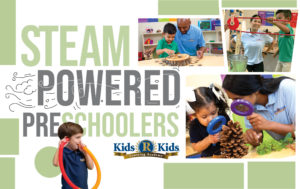
Stacking blocks, dumping water, digging in mud, watching the clouds, mixing paints. Sounds like a regular day of children’s play, doesn’t it? Believe it or not, these activities aren’t just fun ways to keep kids busy. In fact, they’re laying the foundation for a lifetime of curiosity, observation, and learning for budding young scientists. In early childhood, play is in-depth research into what things are, how they work, and how we interact with the world around us.
ABCs to Ph.Ds
According to one survey of working scientists, one third of respondents said a lifelong interest in science was the reason they chose their career paths, which most reported began in early childhood.
Even if your little learners don’t take their talents to the laboratory, STEAM education is a powerful tool for building infant and toddler cognitive developmental skills like executive function, initiative, curiosity, creativity, exploration, reasoning, memory, and problem-solving.
Conducting the STEAM Engine
How can adults support this STEAM-powered learning? Start with a healthy, encouraging, and secure environment. Respecting even the youngest tots as competent, capable learners is key. Creating a safe space for them to be engaged and create with minimal intervention gives children agency to explore and process as they please. It also gives grownups the chance to observe and reflect. Offer a variety of objects and materials to spark problem-solving and innovation, and practice asking open-ended questions, like “what do you think will happen if…” or “tell me what you noticed!”
Exposure to STEAM in early childhood opens the door to a lifetime of wonder, and everyone benefits. So, go ahead and encourage your youngsters to mix up the play dough colors, smell the flowers, knock down the towers. They’re scientists, after all!